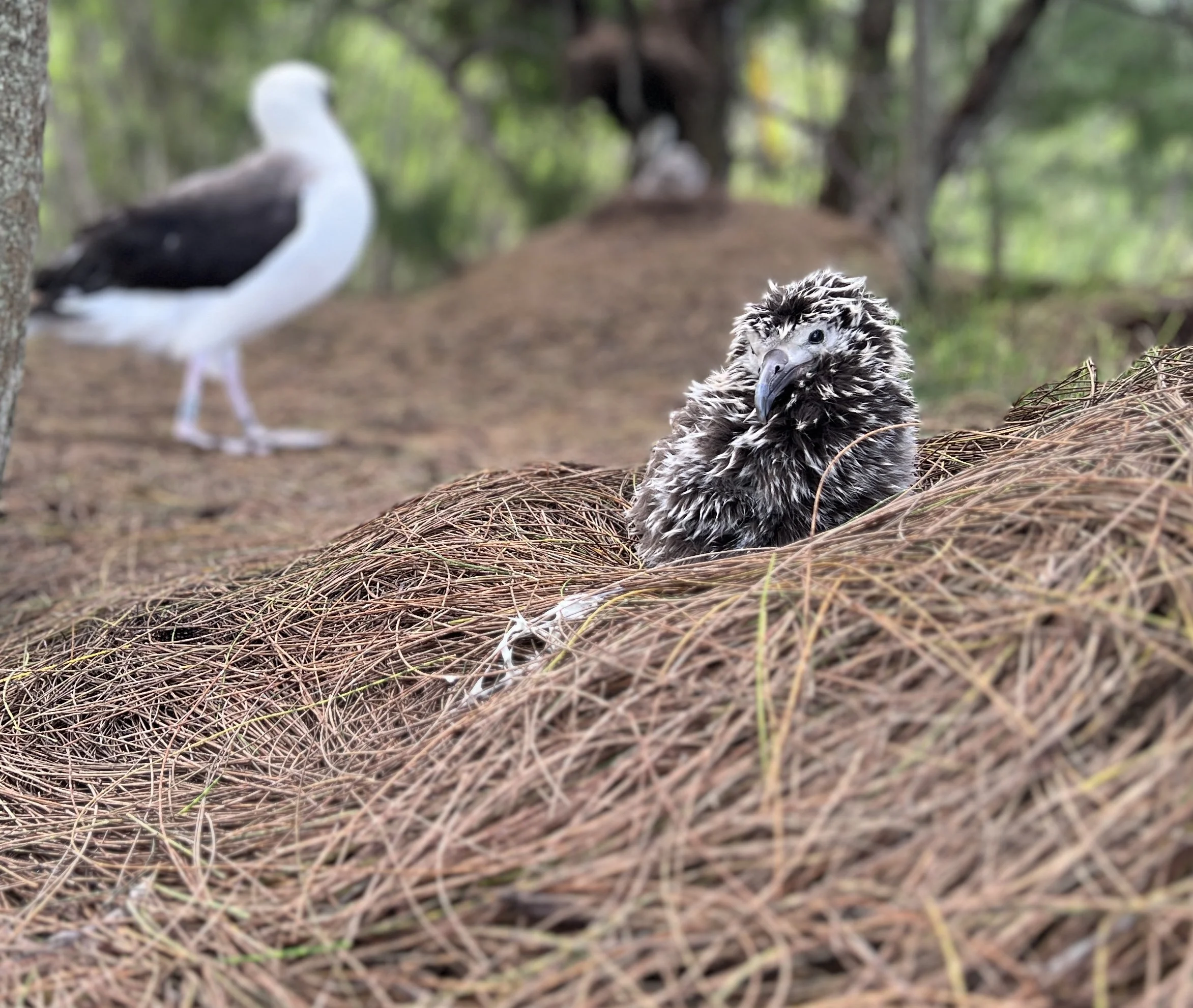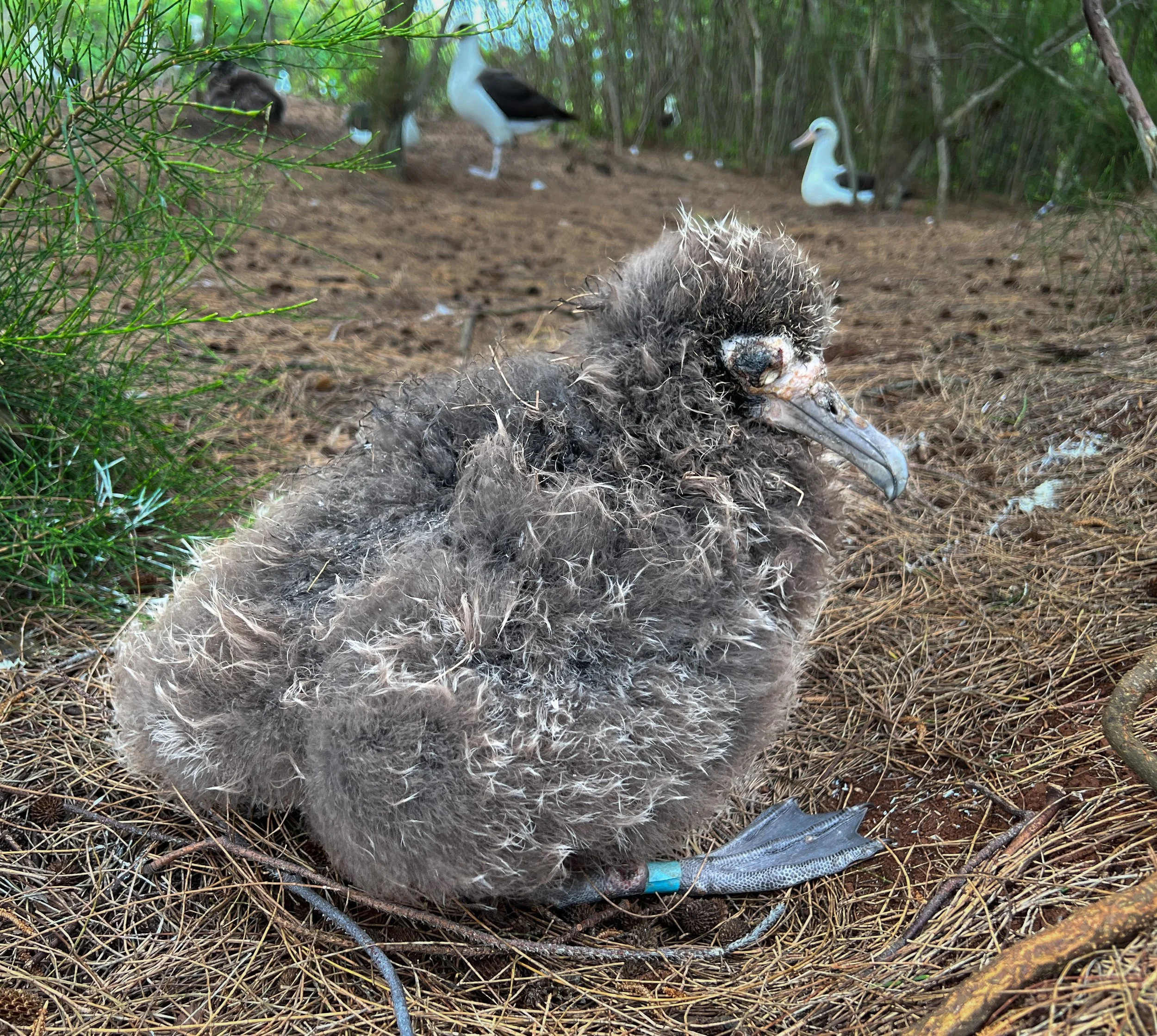One Astonishing Albatross
An Orphaned Mōlī Chick Beats Long Odds
By Safina Center Conservationist-in-Residence Hob Osterlund
Kiernan just over two weeks old. ©Hob Osterlund
The first time I caught myself thinking Kiernan was destined for imminent death, I was soaked to the skin in a squall. At that point the weather forecast was already promising an unusually rainy February, and of course the little albatross chick hadnʻt yet been named. The poor thing was only six days old—too young to be left alone by her parents—shivering in a puddle in her nest, her stubby little wings spread wide in an attempt to gain enough purchase to climb out of the water.
I was surprised and relieved the next day to find her snuggled under the warmth of her father. We knew him from previous seasons to be an excellent dad, but had not documented the presence of Kiernan’s mom in weeks, before K hatched. Had she died at sea?
Kiernan leaves the nest and goes on a walkabout. ©Hob Osterlund
Although Kiernan wasn’t the oldest chick in her colony, she was the first to become mobile. She wandered outside her nest, picking up tidbits from the ironwood forest floor like a curious toddler. This can be a good sign; sadly, it can also mean the chick is underweight and hungry. The latter turned out to be true for little K.
Around that time I got a call from the landowner of Kʻs colony. She had some guests visiting, and asked if I could join them to see the birds. While on site, the landowner offered her friends the opportunity to name a chick. Mary was quickly drawn to K’s adorable wanderings, and dubbed her Kiernan. Maryʻs daughter Sam picked the smallest and latest hatch and named her Hobbes. Later, back at the house, I offered to send them occasional photos of the chicks. I also asked if they wanted to know if the chicks died. I wasnʻt prediciting their deaths, I said, but saw the two as the highest-risk chicks of their cohort. Mary and Sam both said they wanted to know.
As fate would have it, the next day I opened a report emailed to me from the National Oceanic and Atmospheric Administration (NOAA). The report made official that which we feared: Kiernanʻs mother had been killed in the North Pacific in a longline fishing “interaction.” When there is concrete evidence a mōlīparent’s death is directly attributed to human actions, the good folks at Save Our Shearwaters (SOS) can consider feeding that babe in the field. This was no small ask: it would require a highly-skilled person to feed K every three days for about four months—should she live so long—and try not to overlap too closely with dadʻs visits. It would also require a written letter of authorization from the State, since offsite care is outside SOS’s permitted scope of work as a rehabilitation facility.
Kiernan moves into Hobbes’ nest. ©Hob Osterlund
As SOS quickly calculated whether they had the resources to do the job, K did something none of us on Kauaʻi had ever seen a chick do, nor could we find record of happening among albatross species elsewhere in the world. She moved into another nest, one already occupied by a living chick—and it happened to be Hobbes. Hobbesʻ dad was there when K moved in and did not object, which was very surprising. Later when Hobbesʻ mom came home, she didnʻt fuss either. In fact, both parents seemed to take Kiernan in easy stride, as if they expected to have two chicks—something that virtually never occurs. It seemed obvious K was hoping to be fed, but we never documented such a feeding. And despite the scary possibility of losing meals to an interloper, Hobbes appeared to benefit at least a little from Kʻs presence. Before K moved in, Hobbes was frequently seen shivering. She was by far the last hatch in the colony, and didn’t seem to be growing. Kiernan warmed her, and continued to for ten more days. With adequate resources and State authorization in place, SOS first examined K on March 12 and began providing supplemental feeds on March 14. On March 17, Kiernan climbed out of H’s nest and built herself a new one a few feet away. On March 23, without her own personal heating pad and likely without enough food, little Hobbes died. I notified Mary and Sam.
Hobbes’ parents preen Kiernan. ©Hob Osterlund
As Christa from SOS continued to feed K every three days, she discovered a new disconcerting fact: Kʻs dad no longer appeared to be contributing to the effort. I put a trailcam near K to document his visits, but never got a shot of him. Had he too been killed? Had he decided Kʻs health was too compromised, and abandoned her? Had he been unable to find her once she occupied a new nest? Had he returned to sea, heartbroken at the loss of his family?
Kiernan gets case of avian pox. ©Hob Osterlund
Then, as it became clear K had been orphaned, yet another unprecedented problem emerged. Avian pox lesions began to appear on all the chicks, on their bills and feet and eyelids. Itʻs not uncommon to have one or two chicks in a colony have pox, but this time it was 100% of them in all colonies on Kauaʻi, as far as we couldtell. Weʻd had the rainest February (22.3 inches) in many years, but in March we had only 7.2 inches, only slightly more than average. Weʻd seen 53 inches in March of 2012 and 31 inches in March of 2020 with no such pox problem. So why so many pox-carrying mosquitoes this year?
Kiernan had one of the worst cases. Both her eyes were completely covered, and we worried sheʻd be permanently blinded. She had big lesions on her bill, and we worried her nostrils would be blocked. She even had a bloody lesion on her cloaca.
Kiernan, temporarily blinded by pox, monitored by TrailCam. ©Hob Osterlund
The pox continued for all of April and most of May. Three chicks on Kaua’i died by getting lost in deep vegetation due to temporary blindness. Ultimately as the scabs began to fall off, we noticed that Kiernan had a slit of an opening in one eye, and that she was reactive to movement near her feet. Then gradually both her eyes opened, and her vision began to seem normal. Her other lesions began to retreat and dry up. Now, in late June, she walks around the colony fully upright. Her affect is enthusiastic, inquisitive and seemingly unphased by all she’s been through. She tends to hang out near the SOS storage bin under an old ironwood tree, quietly awaiting Christa’s return. (Since there is no danger of albatross imprinting on humans, her caregivers have no need to mask their faces or their efforts.)
Kiernan shows signs of returned eyesight. ©Hob Osterlund
Kiernan is now on track for fledging sometime in July, and of course we hope to see her back on Kaua’i in 4-5 years with others of her graduating class. But whatever happens from here, we have all been astonished by her unprecedented will to live.
Soon, squid willing, I will notify Mary and Sam of Kiernan’s first flight.
Kiernan recovered, a few weeks before anticipated fledge. ©Hob Osterlund
This story is dedicated with deep gratitude to the people who donated to Save Our Shearwaters for the purpose of Kiernanʻs feedings. You know who you are. https://saveourshearwaters.org/



